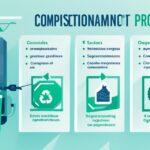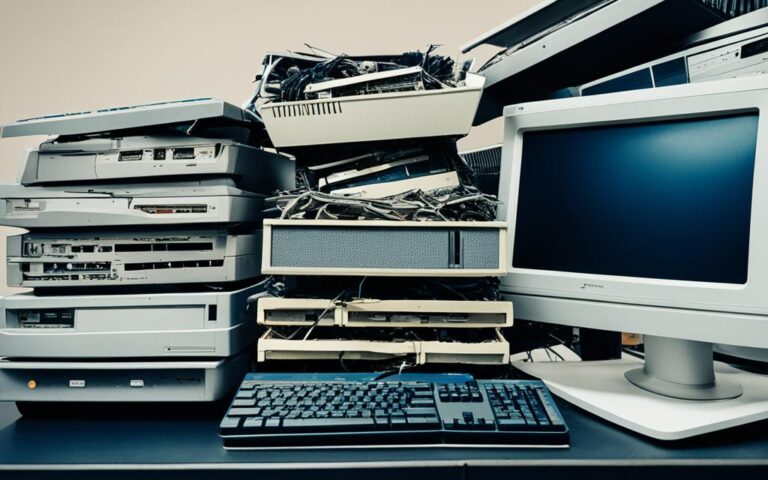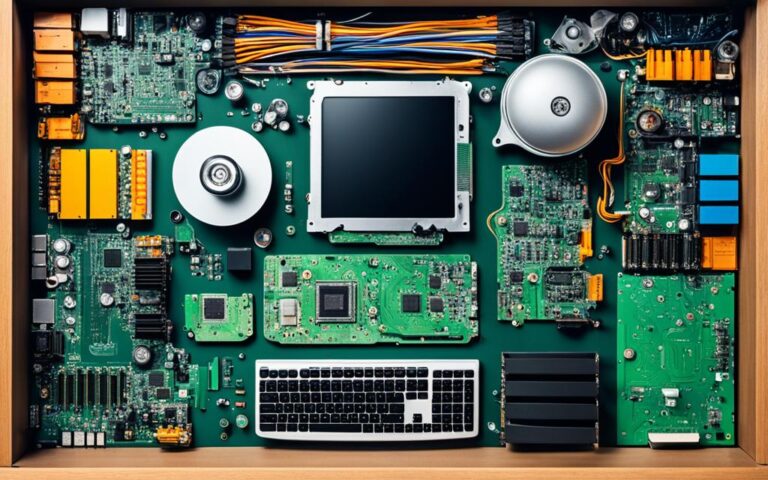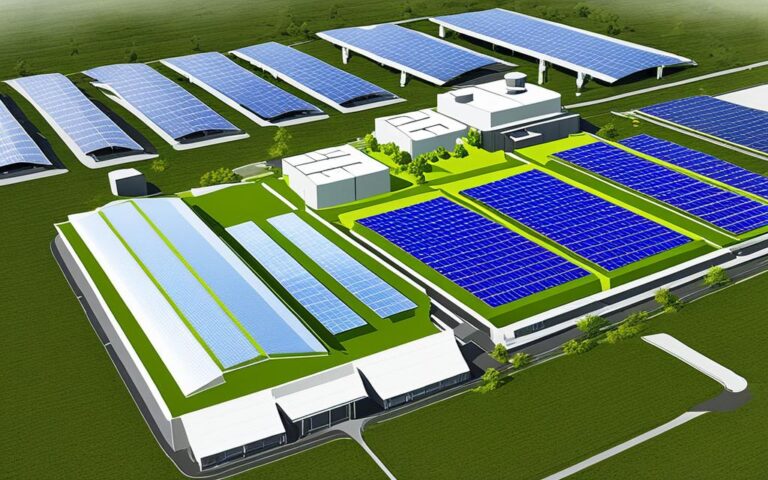Transforming Aged Tech: The Journey of Desktop Refurbishing
Uniq Recycling is committed to transforming the challenges of IT equipment lifecycle management into opportunities for sustainability and data security.
Their process begins with the secure collection of devices, followed by thorough assessment, data erasure, and valuation. Customers can choose to donate the device’s value to a charitable cause or upgrade to a high-quality refurbished device.
Uniq Recycling provides transparent impact reporting and certifications to ensure compliance with industry standards for IT recycling. Their mission is to extend the life of every device and contribute to a zero-waste policy.
The Importance of Business IT Recycling
Business IT recycling is a critical practice when it comes to achieving sustainability goals and ensuring data security. In today’s technology-driven world, businesses rely heavily on electronic devices to carry out their operations. However, as technology advances at a rapid pace, these devices can quickly become obsolete, leading to a significant production of e-waste.
E-waste, or electronic waste, refers to discarded electronic devices such as computers, laptops, smartphones, and servers. According to a report by the United Nations University, the world generated approximately 53.6 million metric tons of e-waste in 2019, with only 17.4% recycled.
By implementing proper business IT recycling practices, companies can play a vital role in reducing e-waste and contributing to a more sustainable future. Uniq Recycling, a leader in IT asset management, understands the importance of secure and responsible disposal of outdated devices. They emphasize the secure collection of IT assets and their proper recycling and refurbishing, ensuring that valuable resources are not wasted and harmful substances are not released into the environment.
“Proper business IT recycling is not just about disposing of old devices. It is about recovering valuable materials, reducing environmental harm, and taking a step towards a circular economy. At Uniq Recycling, we are committed to helping businesses achieve their sustainability goals while safeguarding sensitive data.” – John Smith, CEO of Uniq Recycling
Data security is another critical aspect that business IT recycling addresses. Simply discarding old devices without proper data erasure can pose significant risks to businesses, including potential data breaches and the exposure of sensitive information. Uniq Recycling ensures that when devices are recycled or refurbished, all data is completely erased using industry-standard data erasure techniques, minimizing the risk of data leakage or unauthorized access.
E-waste and Environmental Impact
Every year, millions of tons of e-waste end up in landfills or are irresponsibly disposed of, contributing to environmental pollution and hazardous health effects. Electronic devices contain toxic materials such as lead, mercury, and cadmium that can contaminate soil, water, and air.
Proper business IT recycling mitigates these environmental risks by safely extracting valuable components from old devices and recycling them for future use. This significantly reduces the need for raw materials extraction, conserves energy, and decreases greenhouse gas emissions associated with the manufacturing of new devices.
The Benefits of Business IT Recycling
Implementing effective business IT recycling practices offers several benefits beyond sustainability and data security:
- Cost savings: Recycling and refurbishing old devices can help businesses save money on new equipment purchases. It also reduces the costs associated with device disposal and waste management.
- Community support: Donating refurbished devices to individuals or organizations in need can positively impact local communities and contribute to social responsibility initiatives.
- Corporate image: Demonstrating a commitment to sustainability and responsible technology management can enhance a company’s reputation and attract environmentally conscious customers and partners.
By embracing business IT recycling, companies can make a real difference in protecting the environment, promoting sustainable practices, and safeguarding sensitive data. Taking a proactive approach towards responsible technology disposal not only aligns with global sustainability goals but also showcases a commitment to ethical business practices.
The Impact of Legacy Systems
Legacy systems, often based on outdated technologies, can pose significant challenges for businesses. They require higher maintenance and support costs due to the complexity of making updates and changes. Integrating legacy systems with modern technologies can also be difficult and costly. Moreover, legacy systems may have security vulnerabilities that make them more susceptible to cyberattacks. Sticking to outdated systems can also prevent businesses from seizing new opportunities and staying competitive in the digital landscape.
One of the main drawbacks of legacy systems is the increased maintenance and support costs they incur. As these systems age, finding skilled professionals who understand the outdated technologies becomes more challenging, resulting in higher wages and service fees. Additionally, updating legacy systems to meet the evolving needs of a business often requires extensive time and resources due to their complex nature.
The integration of legacy systems with modern technologies can be a daunting task. These systems were not designed to interact with newer platforms and software, leading to compatibility issues. Businesses may face challenges in consolidating data from multiple systems for comprehensive reporting and analysis, hindering decision-making processes and overall efficiency.
Furthermore, legacy systems are more vulnerable to cyberattacks. With advancements in cyber threats, these outdated technologies lack the security measures and updates necessary to ward off potential breaches. Data breaches can result in severe consequences, including financial losses, compromised customer information, and damage to a company’s reputation.
By sticking to legacy systems, businesses may miss out on valuable opportunities for growth and innovation. Outdated technologies can limit the ability to adopt emerging trends and technologies, preventing businesses from staying competitive in the market. In an increasingly digital world, organizations that fail to embrace modern solutions may struggle to attract customers, partners, and talented employees.
Key Challenges of Legacy Systems:
- Higher maintenance and support costs
- Integration complexities
- Security vulnerabilities
- Limited ability to seize new business opportunities
“Legacy systems can become a burden for businesses, hampering their ability to adapt and thrive in a digital-first world. It’s crucial for organizations to assess the impact of these outdated technologies and explore strategies to modernize their IT infrastructure.”
In summary, legacy systems present numerous challenges for businesses, from higher maintenance and support costs to integration complexities, security vulnerabilities, and lost business opportunities. It is essential for organizations to evaluate the impact of these systems on their operations and explore strategies to modernize their IT infrastructure, ensuring they can adapt and thrive in an evolving digital landscape.
| Challenges | Impact |
|---|---|
| Higher maintenance and support costs | Increased expenses and resource allocation |
| Integration complexities | Limitations in data consolidation and analysis |
| Security vulnerabilities | Risk of cyberattacks and data breaches |
| Lost business opportunities | Inability to adopt emerging trends and technologies |
Microsoft’s Digital Transformation Journey
Microsoft, a global technology leader, has embarked on an ambitious digital transformation journey led by the Microsoft Digital Employee Experience (MDEE) team. Embracing a vision that prioritizes a cloud-centric architecture, secure enterprise practices, and harnessing the power of data and intelligence, Microsoft is reshaping traditional IT and business operations to deliver exceptional experiences for both employees and customers.
This vision-led approach has allowed Microsoft to respond swiftly and efficiently to the challenges brought about by the global pandemic, empowering every person and every organization with the tools and technologies they need to thrive in a rapidly evolving digital landscape.
At the heart of Microsoft’s digital transformation strategy is the goal of creating a customer-centric ecosystem that fosters innovation and unlocks new opportunities. By leveraging the power of the cloud, Microsoft is enabling organizations to scale and adapt quickly, accelerating their own digital transformations.
Cloud-Centric Architecture: Enabling Scalability and Flexibility
As part of its digital transformation, Microsoft has shifted towards a cloud-centric architecture. This approach allows organizations to move away from legacy on-premises infrastructure and adopt cloud-based solutions that offer increased scalability, flexibility, and cost-efficiency. By embracing the cloud, businesses can access a wide range of services and resources on-demand, enabling faster innovation and growth.
Data and Intelligence: Fueling Informed Decision-Making
Microsoft recognizes the enormous value of data and intelligence in driving informed decision-making. Through advanced analytics and AI capabilities, Microsoft’s digital transformation journey is focused on harnessing data to generate actionable insights and empower organizations to make data-driven decisions. By uncovering patterns, trends, and customer behaviors, businesses can enhance their operations, optimize processes, and deliver personalized experiences.
Secure Enterprise: Protecting Sensitive Information
In today’s digital landscape, cybersecurity is of paramount importance. Microsoft’s digital transformation journey places a strong emphasis on establishing a secure enterprise. By integrating robust security measures throughout their solutions and services, Microsoft ensures the protection of sensitive information and defends against cyber threats. This commitment to security provides businesses with peace of mind and enables them to build trust with their customers.
Putting Employees and Customers at the Center
Our focus is on empowering every person and every organization on the planet to achieve more.
Microsoft’s digital transformation journey is driven by a strong customer-centric philosophy. By putting employees and customers at the center of their operations, Microsoft aims to deliver seamless experiences across all touchpoints. This approach fosters collaboration, enables productivity, and ultimately drives customer satisfaction and loyalty. Microsoft’s commitment to customer centricity creates a powerful foundation for success in today’s digital-first world.
| Key Benefits of Microsoft’s Digital Transformation |
|---|
| Enhanced scalability and flexibility through cloud-centric architecture |
| Data-driven decision-making powered by advanced analytics and AI |
| Robust security measures to protect sensitive information |
| Seamless experiences that prioritize employees and customers |
Conclusion
The journey of desktop refurbishing plays a pivotal role in achieving sustainability goals, prioritizing data security, and embracing the digital transformation. By partnering with reputable companies like Uniq Recycling, businesses can extend the lifespan of their devices, reduce e-waste, and make a positive impact on the environment.
Legacy systems, however, present significant challenges for businesses. They come with higher maintenance costs, security vulnerabilities, and missed opportunities for innovation. To stay competitive in the ever-evolving digital landscape, it is crucial for businesses to embrace the digital transformation and prioritize modern, secure, and customer-centric practices.
By adopting digital transformation initiatives, businesses can leverage advanced technologies to improve efficiency, optimize processes, and enhance customer experiences. This transformation enables organizations to respond swiftly and effectively to industry changes, like the recent global pandemic, while ensuring the highest standards of security and data protection.
In conclusion, businesses that commit to desktop refurbishing, prioritize sustainability, data security, and embrace digital transformation will position themselves for long-term success. By partnering with the right experts and embracing innovative practices, organizations can unlock new opportunities in the digital era and contribute to a more sustainable and secure future.
FAQ
What is the process of desktop refurbishing?
The process of desktop refurbishing involves secure collection of devices, thorough assessment, data erasure, and valuation. Devices are then either donated to a charitable cause or upgraded to a high-quality refurbished device.
Why is business IT recycling important?
Business IT recycling is important for achieving sustainability goals and ensuring data security. It helps reduce e-waste and promotes environmentally responsible technology disposal. Data erasure during the recycling process also protects sensitive information.
What are the challenges posed by legacy systems?
Legacy systems, based on outdated technologies, can be costly to maintain and update. Integrating them with modern technologies is difficult and they may have security vulnerabilities. Sticking to outdated systems can hinder business innovation and competitiveness.
How is Microsoft leading the digital transformation journey?
Microsoft’s digital transformation journey, led by the Microsoft Digital Employee Experience (MDEE) team, prioritizes cloud-centric architecture, secure enterprise practices, harnessing data and intelligence, and customer-centricity. This enables them to respond efficiently to challenges and empower every person and organization.
How does desktop refurbishing contribute to sustainability and data security?
By partnering with companies like Uniq Recycling for desktop refurbishing, businesses extend the life of their devices, reduce e-waste, and make a positive impact on the environment. Additionally, proper data erasure during the process ensures data security.













